100% Valid 70-467 Exam Pass Tips: PassLeader’s 70-467 191q exam dumps were updated in recent days with the change of new 70-467 exam questions, PassLeader ensure the 70-467 191q braindumps are the newest and the most valid, our 70-467 191q practice test will help you 100 percent pass 70-467 exam. Visit passleader.com and get the 70-467 191q exam questions with PDF and VCE. New version vce player is also free now.
keywords: 70-467 exam,70-467 191q exam dumps,70-467 191q exam questions,70-467 pdf dumps,70-467 vce dumps,70-467 braindump,Designing Business Intelligence Solutions with Microsoft SQL Server 2012 Exam
QUESTION 36
Drag and Drop Questions
You are designing a SQL Server Reporting Services (SSRS) solution. A report project must access multiple SQL Server databases. Each database is on a different instance. The databases have identical schema and security configurations. You have the following requirements:
– The report must support subscriptions.
– Users must be able to select the host when running the report.
What should you do? To answer, drag the appropriate phrase or phrases from the list to the correct location or locations in the answer area. (Answer choices may be used once, more than once, or not all.)

QUESTION 37
Drag and Drop Questions
You are designing a SQL Server Reporting Services (SSRS) solution. An existing report aggregates data from a SQL Azure database in a chart. You need to use the chart in a new report and ensure that other users can use the chart in their reports. Which three actions should you perform in sequence? (To answer, move the appropriate actions from the list of actions to the answer area and arrange them in the correct order,)
Answer: 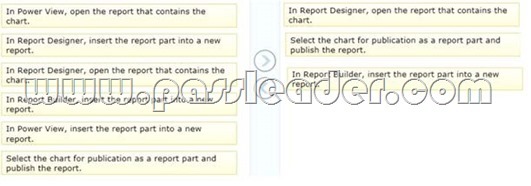
QUESTION 38
You are designing a multidimensional OLAP (MOLAP) cube. The MOLAP cube must meet the following requirements: Ensure that workloads for aggregation tuning can be automatically collected. Require the least amount of effort to perform manual aggregation tuning. Minimize impact on the performance of previously tuned queries. You need to design a MOLAP cube that meets the requirements. What should you do? (More than one answer choice may achieve the goal. Select the BEST answer.)
A. Enable SQL Server Analysis Services (SSAS) query logging.
Run the Usage-Based Optimization Wizard to generate aggregations.
Merge the wizard results with existing aggregation designs.
B. Set up multiple partitions.
Run the Aggregation Design Wizard periodically for each measure group.
After the wizard finishes, discard the old aggregation design and accept the new one.
C. Set up multiple partitions.
Run the Aggregation Design Wizard on each partition.
Schedule the aggregations by using an XMLA script in SQL Server Agent.
D. Set the AggregationUsage property of all attributes based on natural keys to Full.
Answer: A
QUESTION 39
You are designing a fact table in a SQL Server database. The fact table must meet the following requirements:
– Include a columnstore index.
– Allow users to choose up to 10 dimension tables and up to five facts at one time.
– Maximize performance of queries that aggregate measures by using any of the 10 dimensions.
– Support billions of rows.
– Use the most efficient design strategy.
You need to design the fact table to meet the requirements. What should you do? (More than one answer choice may achieve the goal. Select the BEST answer.)
A. Design a fact table with 5 dimensional key columns and 10 measure columns.
Place the columnstore index on the dimensional key columns.
B. Design a fact table with 5 dimensional key columns and 10 measure columns.
Place the columnstore index on the measure columns.
C. Design a fact table with 10 dimensional key columns and 5 measure columns.
Place the columnstore index on the dimensional key columns and the measure columns.
D. Design a fact table with 10 dimensional key columns and 5 measure columns.
Place the columnstore index on only the measure columns.
Answer: C
QUESTION 40
Drag and Drop Questions
You are designing a SQL Server Analysis Services (SSAS) data model on a very large data warehouse. The fact tables in the data warehouse contain terabytes of data in tens of billions of rows. You must support the following features:
– Complex attribute/column relationships
– Advanced calculations in the data model definition
– Advanced calculations using logic deployed in a custom assembly
You need to choose the correct SSAS design strategy. What should you do? To answer, drag the appropriate term or terms to the correct location or locations in the answer area. (Answer choices may be used once, more than once, or not all.)
Answer: 
QUESTION 41
You are creating a Multidimensional Expressions (MDX) calculation for Projected Revenue in a cube. For Product A, Projected Revenue is defined as 150 percent of the Total Sales of the product. For all other products, Projected Revenue is defined as 110 percent of the Total Sales of the product. You need to calculate the Projected Revenue as efficiently as possible. Which calculation should you use? (More than one answer choice may achieve the goal. Select the BEST answer.)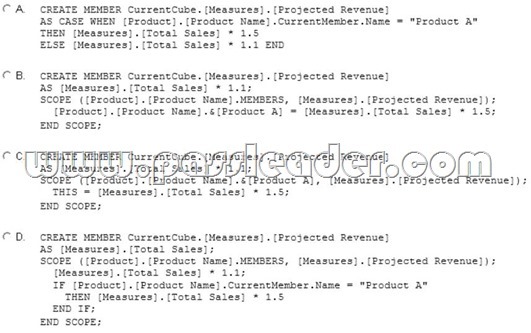
A. Option A
B. Option B
C. Option C
D. Option D
Answer: C
QUESTION 42
You are defining a named set by using Multidimensional Expressions (MDX) in a sales cube. The cube includes a Customer dimension that contains a Geography hierarchy and a Gender attribute hierarchy. You need to return only the female customers in the Geography hierarchy. Which set should you use? (More than one answer choice may achieve the goal. Select the BEST answer.)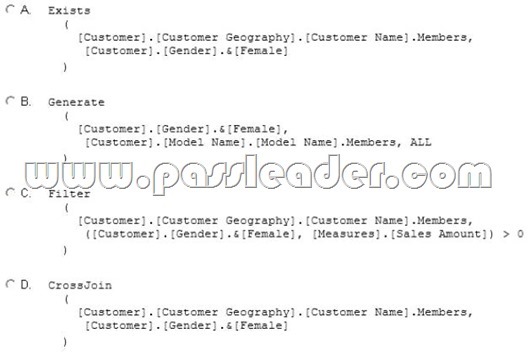
A. Option A
B. Option B
C. Option C
D. Option D
Answer: A
QUESTION 43
Hotspot Questions
You are designing a SQL Server Integration Services (SSIS) package configuration strategy. The package configuration must meet the following requirements:
– Include multiple properties in a configuration.
– Force packages to load all settings in the configuration.
– Support Encrypting File System (EFS) formats.
You need to select the appropriate configuration. Which configuration type should you use? To answer, select the appropriate option from the drop-down list in the dialog box.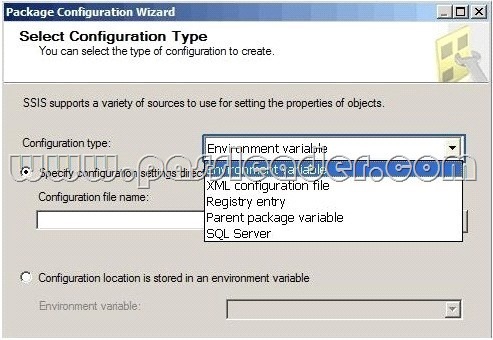
Answer: 
QUESTION 44
You are designing a SQL Server Integration Services (SSIS) solution that will load multiple Online Transactional Processing (OLTP) data sources into a SQL Server data mart. You have the following requirements:
– Ensure that the process supports the creation of an exception report that details possible duplicate key values, null ratios within columns, and column-length distributions of values.
– Ensure that users can generate the exception report in an XML format.
– Use the minimum development effort.
You need to design the SSIS solution to meet the requirements. What should you do? (More than one answer choice may achieve the goal. Select the BEST answer.)
A. Use a Data Profiling task.
Use a Data Flow task to extract the XML output of the Data Profiling task into a SQL Server table.
Query the table to view the exceptions.
B. Use Data Flow tasks to process the clean data.
C. Use a Data Profiling task. Read the exceptions in Data Profile Viewer.
D. Design a stored procedure that examines data for common dirty data patterns.
Use an Execute SQL task.
Answer: C
QUESTION 45
You are designing a SQL Server Integration Services (SSIS) solution. The solution will contain an SSIS project that includes several SSIS packages. Each SSIS package will define the same connection managers and variables. You have the following requirements:
– The deployment model must support changing the content of connection strings by using parameters at execution time.
– The deployment model must automatically log events to the SSISOB database.
– Maximize performance at execution time.
You need to design a solution that meets the requirements. What should you do? (More than one answer choice may achieve the goal. Select the BEST answer.)
A. Use a project deployment model.
Modify connection manager properties to use project parameters.
B. Use a package deployment model.
Save each SSIS package to a file share that can be accessed from all environments.
C. Use a package deployment model.
Configure connections in an XML configuration file referenced by an environment variable that corresponds to the SQL Server environment of each SSIS package.
D. Use a project deployment model.
Modify connection manager properties to use package parameters.
Answer: A
QUESTION 46
Drag and Drop Questions
You are administering a SQL Server Analysis Services (SSAS) database on a server. The database hosts a financial cube based on a SQL Azure database. You need to grant read access to the financial cube for all users in the group USA\PowerUsers. Which three actions should you perform in sequence? (To answer, move the appropriate actions from the list of actions to the answer area and arrange them in the correct order.)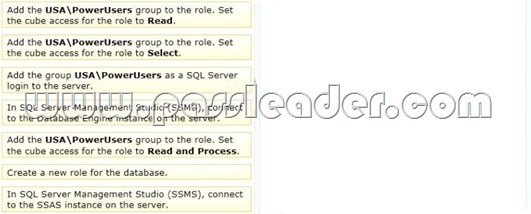
Answer: 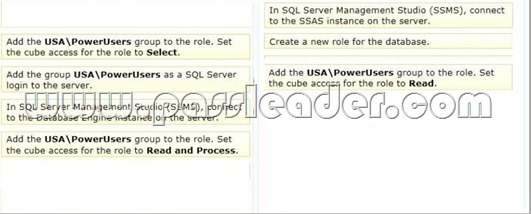
http://www.passleader.com/70-467.html
Case Study: 1 – Tailspin Toys Case A(QUESTION 47 – QUESTION 59)
Background
You are the business intelligence (BI) solutions architect for Tailspin Toys. You produce solutions by using SQL Server 2012 Business Intelligence edition and Microsoft SharePoint Server 2010 Service Pack 1 (SP1) Enterprise edition.
Technical Background
Extract, transform, load (ETL) processes populate the data warehouse every 24 hours.
ETL Processes
One SQL Server Integration Services (SSIS) package is designed and developed to populate each data warehouse table. The primary source of data is extracted from a SQL Azure database. Secondary data sources include a Microsoft Dynamics CRM 2011 on-premises database. ETL developers develop packages by using the SSIS project deployment model. The ETL developers are responsible for testing the packages and producing a deployment file. The deployment file is given to the ETL administrators. The ETL administrators belong to a Windows security group named SSISOwners that maps to a SQL Server login named SSISOwners.
Data Models
The IT department has developed and manages two SQL Server Analysis Services (SSAS) BI Semantic Model (BISM) projects: Sales Reporting and Sales Analysis. The Sales Reporting database has been developed as a tabular project. The Sales Analysis database has been developed as a multidimensional project. Business analysts use PowerPivot for Microsoft Excel to produce self-managed data models based directly on the data warehouse or the corporate data models, and publish the PowerPivot workbooks to a SharePoint site. The sole purpose of the Sales Reporting database is to support business user reporting and ad-hoc analysis by using Power View. The database is configured for DirectQuery mode and all model queries result in SSAS querying the data warehouse. The database is based on the entire data warehouse. The Sales Analysis database consists of a single SSAS cube named Sales. The Sales cube has been developed to support sales monitoring, analysts, and planning. The Sales cube metadata is shown in the following graphic.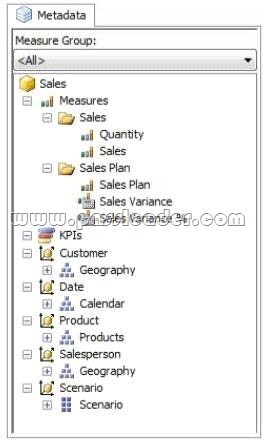
Details of specific Sales cube dimensions are described in the following table.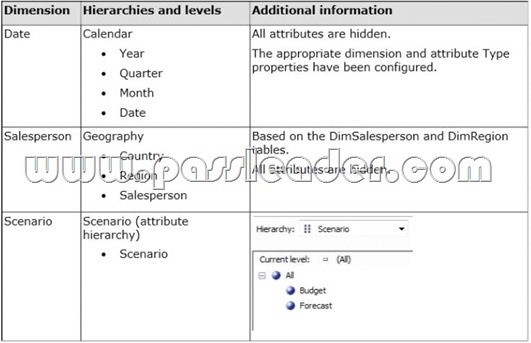
The Sales measure group is based on the FactSales table. The Sales Plan measure group is based on the FactSalesPlan table. The Sales Plan measure group has been configured with a multidimensional OLAP (MOLAP) writeback partition. Both measure groups use MOLAP partitions, and aggregation designs are assigned to all partitions. Because the volumes of data in the data warehouse are large, an incremental processing strategy has been implemented. The Sales Variance calculated member is computed by subtracting the Sales Plan forecast amount from Sales. The Sales Variance ?o calculated member is computed by dividing Sales Variance by Sales. The cube’s Multidimensional Expressions (MDX) script does not set any color properties.
Analysis and Reporting
SQL Server Reporting Services (SSRS) has been configured in SharePoint integrated mode. A business analyst has created a PowerPivot workbook named Manufacturing Performance that integrates data from the data warehouse and manufacturing data from an operational database hosted in SQL Azure. The workbook has been published in a PowerPivot Gallery library in SharePoint Server and does not contain any reports. The analyst has scheduled daily data refresh from the SQL Azure database. Several SSRS reports are based on the PowerPivot workbook, and all reports are configured with a report execution mode to run on demand. Recently users have noticed that data in the PowerPivot workbooks published to SharePoint Server is not being refreshed. The SharePoint administrator has identified that the Secure Store Service target application used by the PowerPivot unattended data refresh account has been deleted.
Business Requirements
ETL Processes
All ETL administrators must have full privileges to administer and monitor the SSIS catalog, and to import and manage projects.
Data Models
The budget and forecast values must never be accumulated when querying the Sales cube. Queries should return the forecast sales values by default. Business users have requested that a single field named SalespersonName be made available to report the full name of the salesperson in the Sales Reporting data model. Writeback is used to initialize the budget sales values for a future year and is based on a weighted allocation of the sales achieved in the previous year.
Analysis and Reporting
Reports based on the Manufacturing Performance PowerPivot workbook must deliver data that is no more than one hour old. Management has requested a new report named Regional Sales. This report must be based on the Sales cube and must allow users to filter by a specific year and present a grid with every region on the columns and the Products hierarchy on the rows. The hierarchy must initially be collapsed and allow the user to drill down through the hierarchy to analyze sales. Additionally, sales values that are less than S5000 must be highlighted in red.
Technical Requirements
Data Warehouse
Business logic in the form of calculations should be defined in the data warehouse to ensure consistency and availability to all data modeling experiences. The schema design should remain as denormalized as possible and should not include unnecessary columns. The schema design must be extended to include the product dimension data.
ETL Processes
Package executions must log only data flow component phases and errors.
Data Models
Processing time for all data models must be minimized. A key performance indicator (KPI) must be added to the Sales cube to monitor sales performance. The KPI trend must use the Standard Arrow indicator to display improving, static, or deteriorating Sales Variance % values compared to the previous time period.
Analysis and Reporting
IT developers must create a library of SSRS reports based on the Sales Reporting database. A shared SSRS data source named Sales Reporting must be created in a SharePoint data connections library.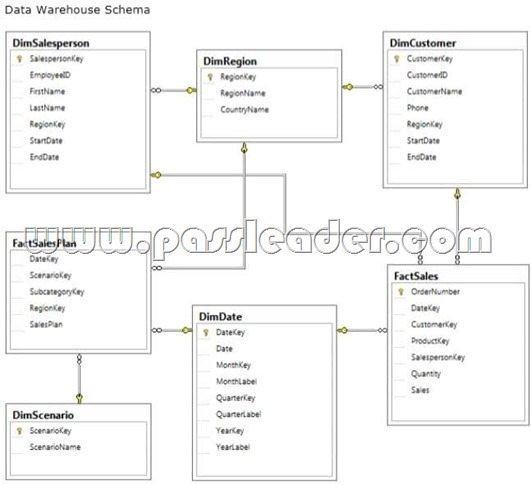
QUESTION 47
You need to fix the PowerPivot data refresh problem by using the least amount of administrative effort. What should you do?
A. Use the PowerPivot Configuration Tool and select the Upgrade Features, Services, Applications and Solutions option.
B. Use the PowerPivot Configuration Tool and select the Configure or Repair PowerPivot for SharePoint option.
C Reinstall SSAS in PowerPivot for SharePoint mode by using the SQL Server 2012 installation media.
D. In SharePoint Central Administration, create a target application and configure the PowerPivot service application settings to use the target application.
Answer: B
QUESTION 48
You need to grant appropriate permissions to the SSISOwners SQL Server login. What should you do?
A. Map the login to the SSISDB database.
Assign the user to the ssis_admin role.
B. Map the login to the msdb database.
Assign the user to the db_owner role.
C. Map the login to the msdb database.
Assign the user to the db_ssisadmin role.
D. Map the login to the SSISDB database.
Assign the user to the db_ssisadmin role.
E. Map the login to the SSISDB database.
Assign the user to the db_owner role.
F. Map the login to the msdb database.
Assign the user to the ssis_admin role.
Answer: C
QUESTION 49
You need to configure the Scenario attribute to ensure that business users appropriately query the Sales Plan measure. What should you do? (Each correct answer presents part of the solution. Choose all that apply.)
A. Set the AttributeHierarchyVisible property to False.
B. Set the IsAggregatable property to False.
C. Set the Usage property to Parent.
D. set the DefaultMember property to the Forecast member.
E. Set the AttributeHierarchyEnabled property to False.
F. Set the RootMemberIf property to ParentIsMissing.
Answer: CD
QUESTION 50
Drag and Drop Questions
You need to configure the attribute relationship types for the Salesperson dimension. Which configuration should you use? To answer, drag the appropriate pair of attributes and attribute relationships from the list to the correct location or locations in the answer area. (Answer choices may be used once, more than once, or not all.)
Answer: 
QUESTION 51
You need to define the trend calculation for the sales performance KPI. Which KPI trend MDX expression should you use?
A. CASE
WHEN [Sales Variance %] < ([Sales Variance %], [Date].[Calendar].PrevMember)
THEN -1 WHEN [Sales Variance %] =
([Sales Variance %], [Date].[Calendar].PrevMember) THEN 0 ELSE 1 END
B. IIF([Sales Variance %3 < ([Sales Variance %], [Date].[Calendar].PrevMember), 1, 0)
C. IIF([Sales Variance %] < ([Sales Variance %], [Date].[Calendar].PrevMember), 0, 1)
D. CASE
WHEN [Sales Variance %] < ([Sales Variance %], [Date].[Calendar].PrevMember)
THEN 1 WHEN [Sales Variance %] =
([Sales Variance %], [Date].[Calendar].PrevMember) THEN 0 ELSE -1 END
Answer: A
QUESTION 52
Drag and Drop Questions
You need to extend the schema design to store the product dimension data. Which design should you use? To answer, drag the appropriate table or tables to the correct location or locations in the answer area. (Fill from left to right. Answer choices may be used once, more than once, or not all.)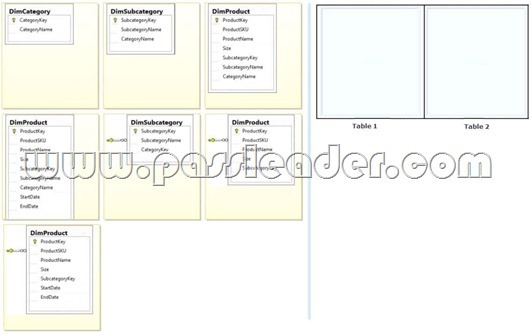
Answer: 
QUESTION 53
You need to configure package execution logging to meet the requirements. What should you do?
A. Configure logging in each ETL package to log the OnError, Onlnformation, and Diagnostic events.
B. Set the SSIS catalog’s Server-wide Default Logging Level property to Performance.
C. Set the SSIS catalog’s Server-wide Default Logging Level property to Basic.
D. Set the SSIS catalog’s Server-wide Default Logging Level property to Verbose.
E. Configure logging in each ETL package to log the OnError, OnPreExecute, and OnPostExecute events.
Answer: B
QUESTION 54
You need to create the Sales Reporting shared SSRS data source. Which SSRS data connection type should you use?
A. OData
B. Microsoft SQL Server
C. ODBC
D. OLE DB
Answer: B
QUESTION 55
You need to select an appropriate tool for creating the Regional Sales report. Which tool or tools should you use? (Each correct answer presents a complete solution. Choose all that apply.)
A. Excel 2010, using the CUBE functions
B. Power View, using a Matrix
C. Excel 2010, using a PivotTable
D. Report Builder, using a Matrix
Answer: BCD
QUESTION 56
You need to select an appropriate tool for creating the Regional Sales report. Which tools or tools should you use? (Each Answer presents a complete solution. Choose all that apply.)
A. Power View, using a table configured for vertical multiples
B. Excel 2010, using a PivotTable
C. Report Builder, using a Matrix
D. Power View, using a table configured for horizontal multiples
Answer: BC
QUESTION 57
You need to create the calculation for SalespersonName. What should you do? (Each Answer presents a complete solution. Choose all that apply.)
A. Create a computed column in the data warehouse’s DimSalesperson table.
Include the column in the Sales Reporting model’s Salesperson table.
B. Modify the data warehouse’s DimSalesperson table and add a new column.
Use an UPDATE statement to populate the new column with values.
Update the SSIS package developed to populate the data warehouse’s DimSalesperson table to use a Derived Column transformation to produce the calculation.
C. Configure the Sales Reporting model’s Salesperson table properties to be based on a query.
Define a derived column in the query.
D. Add a calculated column to the Sales Reporting model’s Salesperson table by using the Data Analysis
Expressions (DAX) language CONCATENATE function.
E. Create a view in the data warehouse that defines a derived column based on the DimSalesperson table.
Base the Sales Reporting model’s Salesperson table on the view.
Include the column in the Sales Reporting model’s Salesperson table.
F. Add a calculated column to the Sales Reporting model’s Salesperson table by using the Data Analysis
Expressions (DAX) language ADDCOLUMNS function.
Answer: BE
QUESTION 58
You need to configure data refresh for the Manufacturing Performance PowerPivot workbook. What should you do? (Each Answer presents part of the solution. Choose ail that apply.)
A. Configure the PowerPivot Data Refresh Timer Job to run every 60 minutes.
B. Restore the PowerPivot workbook to an SSAS instance in tabular mode.
C. Script a process command and configure a SQL Server Agent job to execute the command every 60 minutes.
D. Restore the PowerPivot workbook to an SSAS instance in PowerPivot for SharePoint mode.
Answer: A
QUESTION 59
You need to complete the following UPDATE statement to initialize the budget sales values for 2012. Which MDX weight value expression should you use? To answer, drag the appropriate weight value expression to the answer area.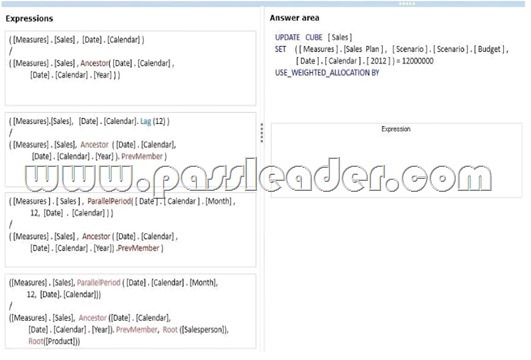
Answer: 
